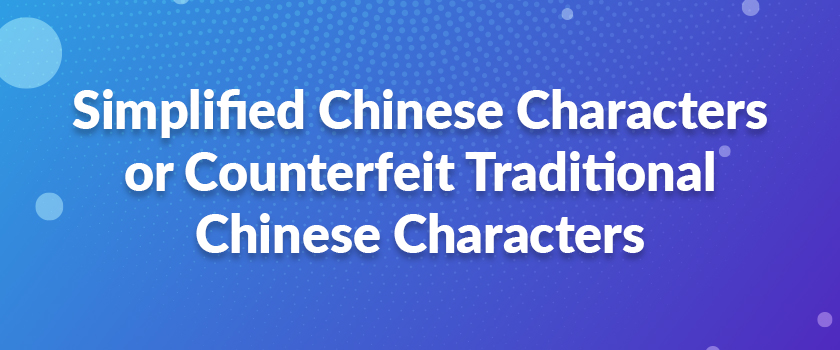A Quick Way to Distinguish Simplified Chinese Characters or Counterfeit Traditional Chinese Characters in a Big5 File (I)
Not a few people living in Chinese Mainland find it hard to distinguish simplified characters or counterfeit traditional characters from genuine traditional characters, especially when those simplified characters or counterfeit characters are mixed up with genuine ones.
That is to say, it is not easy to pick such errors out in a Big5 file that contains only one or several CHS characters or improper CHT characters. So the problem arises. It will easily lead to a quality complaint from the client. The client would complain: “Why are there some simplified Chinese characters in the CHT translation?” As we know, if both CHS and CHT characters are in the same file, there will be display/corruption and other issues. What is worst is losing trust of the client, which is something that we cannot afford.
Is there any solution to solve this issue? Besides that no CHS linguists are allowed to work on CHT projects, there is an easy-to-operate way to distinguish simplified Chinese characters or counterfeit traditional Chinese characters in a big5 file. Now let me to show you how to solve the issue.
☆ For doc. files:
1. Click “File” and “Save as”.
The “Save as” pop-up window will appear.
2. Click under the “Save File as Type(T):” to choose “Text files (*.txt)” and click “Save”
The “File Conversion” pop-up window will appear:
3. Click “Other Encoding(O):” and choose “Traditional Chinese (Big5)”
4. In the “Preview” window you can find Simplified Chinese Characters or Counterfeit Traditional Chinese Characters are appear in red.
☆ For non-doc. files:
You just need add one step before carrying out the above 4 steps. That is:
Copy all contents in the non-doc. file to a doc. file;
Or
Save the non-doc. file as a doc. file.
Then follow the procedure described above.
Read Also: The Thinking Mode of The Chinese Language
Let’s take the following text for example:
XXX 在布朗克斯、布鲁克林、皇后区、斯塔顿岛、曼哈顿这些地区均提供有联邦政府認證的醫療中心 (FQHC) 服务。
無論是幫助您與我們服務的社區互動,或是将我们的服务和福利整合以形成简单高效的經營模式,XXX 始终相信溝通的力量。
您加入我們的網路之後,便可利用我們為聯邦醫療保險(紅藍卡)和州醫療輔助(白卡)患者所提供的資源,並且所有與服務相關的問題將由一位單點联絡人為您快速解答。
After carefully reading through the above text, let alone giving a quick glance at it, it is not easy for us to identify all simplified Chinese characters in the CHT translation, because we always read materials written in simplified Chinese language and are not sensitive enough to CHT characters. However, you can identify all such errors in a minute through the above procedure.
If you check for non-genuine CHT characters with the above procedure, you will find the below window in Step 4 or 5.
It is amazing, isn’t? The mixed CHS characters are all picked out. Then you can correct such errors one by one and ensure to meet the client’s requirements.
Take a look at how we helped our client by localizing their project for Chinese language. Click here to read the complete case study









